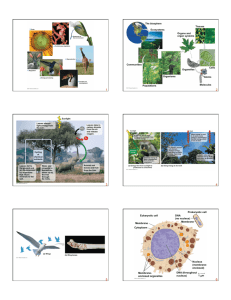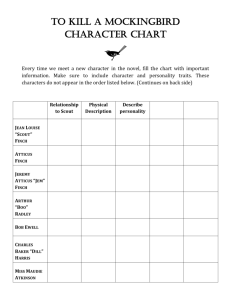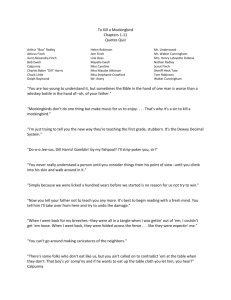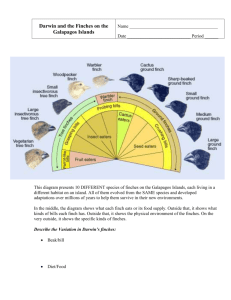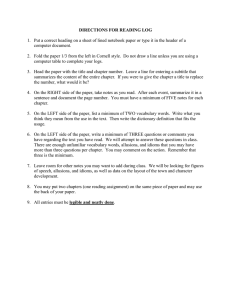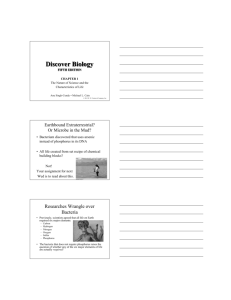Chapter 1 The Science of Biology
advertisement
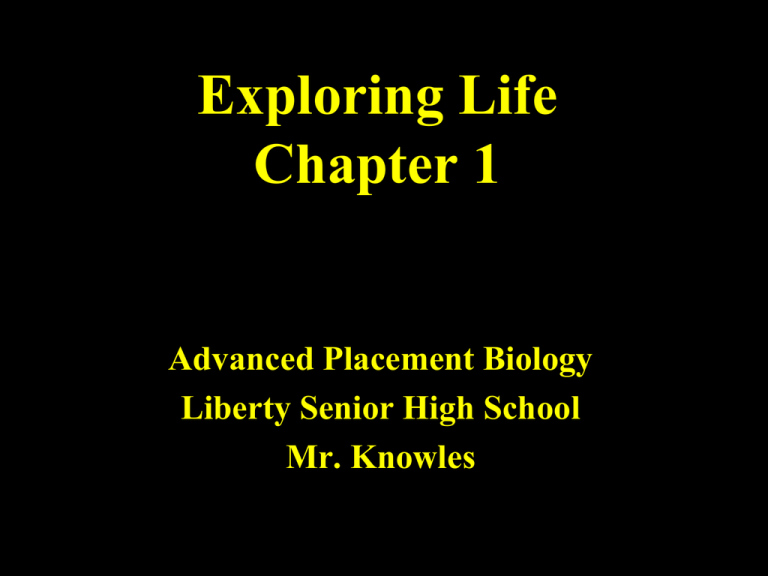
Exploring Life Chapter 1 Advanced Placement Biology Liberty Senior High School Mr. Knowles Life • Defies a simple, one-line definition. • Lends itself to mysticism. Figure 1.1 What is biology? Biology • Bios = Greek for “life” • Logos = Greek for “study” or “thought” • Biology - the study of living things • Concept 1.1: Biologists explore life from the microscopic to the global scale. • The study of life: –Extends from the microscope scale of molecules and cells to the global scale of the entire living planet. What does it mean to be alive? What characteristics define life? What are the criteria for something to be alive? (b) Evolutionary adaptation (a) Order (c) Response to the environment (d) Regulation (e) Energy processing (f) Growth and development Figure 1.2 (g) Reproduction What does it mean to be “living?” Some Characteristics: 1. Order- have a hierarchical organization (Fig 1.3). A Hierarchy of Biological Organization • The hierarchy of life –Extends through many levels of biological organization • From the biosphere to organisms… 1 The biosphere 1.a. biome 2. Ecosystems 3. Communities 4. Populations Figure 1.3 5. Organisms • From cells to atoms. 9 Organelles 1 µm Cell 8 Cells Atoms 10 µm 7 Tissues 50 µm 6 Organs and organ systems Figure 1.3 10 Molecules Order Beyond the Organism • Population- a group of individuals of same species occupying a given area at the same time. • Community- a number of interacting populations in a common environment. Order in Biology • Ecosystem- organisms (biotic) interacting with their nonliving (abiotic) environment. • Biomes- major groupings of plants, animals, and microorganisms that occur over a wide geography and have distinct characteristics (ex. deserts, tropical rainforests) The Emergent Properties of Systems • Biological systems are much more than the sum of their parts. • Due to increasing complexity –New properties emerge with each step upward in the hierarchy of biological order What does it mean to be “living?” 2. Responsiveness or Sensitivityhave a response to stimuli. • Chemotactic • Phototactic • Thigmotropic • Gravitropic Is fire alive? A Closer Look at Cells • The cell – Is the lowest level of organization that can perform all activities required for life Figure 1.5 25 µm The Cell’s Heritable Information • Cells contain chromosomes made partly of DNA, the substance of genes – Which program the cells’ production of proteins and transmit information from parents to offspring Sperm cell Nuclei containing DNA Egg cell Figure 1.6 Fertilized egg with DNA from both parents Embyro’s cells with copies of inherited DNA Offspring with traits inherited from both parents • The molecular structure of DNA – Accounts for it information-rich nature. Nucleus DNA Cell A Nucleotide C T A T A C C G T A G T A Figure 1.7 (a) DNA double helix. This model shows each atom in a segment of DNA.Made up of two long chains of building blocks called nucleotides, a DNA molecule takes the three-dimensional form of a double helix. (b) Single strand of DNA. These geometric shapes and letters are simple symbols for the nucleotides in a small section of one chain of a DNA molecule. Genetic information is encoded in specific sequences of the four types of nucleotides (their names are abbreviated here as A, T, C, and G). What does it mean to be “living?” 3. Growth, Development, and Reproduction- all use hereditary molecules to pass genetic information to offspring. Two Main Forms of Cells • All cells share certain characteristics –They are all enclosed by a membrane –They all use DNA as genetic information • There are two main forms of cells: –Eukaryotic –Prokaryotic • Prokaryotic cells – Lack the kinds of membrane-enclosed organelles found in eukaryotic cells. EUKARYOTIC CELL PROKARYOTIC CELL DNA (no nucleus) Membrane Membrane Cytoplasm Organelles Figure 1.8 Nucleus (contains DNA) 1 µm What does it mean to be “living?” 4. Regulation- have regulatory mechanisms to coordinate functions (transportation of nutrients, wastes, etc.); maintain homeostasis. Feedback Regulation in Biological Systems • A kind of supply-and-demand economy: –Applies to some of the dynamics of biological systems. –The output, or product, of a process regulates that very process feedback regulation. • In negative feedback: – An accumulation of an end product slows the process that produces that product. A Negative feedback Enzyme 1 B A Enzyme 1 B Enzyme 2 C C Enzyme 3 D D Figure 1.11 D D D D D D D D D • In positive feedback: –The end product speeds up production. W W Enzyme 4 Enzyme 4 X Positive feedback X Enzyme 5 Enzyme 5 Y Y Enzyme 6 Z Z Z Z Z Z Z Z Figure 1.12 Enzyme 6 Z Z Z Z Z Z Z Z Z Z Z Question: Are viruses alive? Grouping Species: The Basic Idea • Diversity is a hallmark of life. • Taxonomy: –is the branch of biology that names and classifies species according to a system of broader and broader groups • Classifying life Species Genus Family Order Class Phylum Ursus americanus (American black bear) Ursus Ursidae Carnivora Mammalia Chordata Animalia Figure 1.14 Eukarya Kingdom Domain The Three Domains of Life • At the highest level, life is classified into three domains: – Bacteria – Archaea – Eukarya • Domain Bacteria and domain Archaea – Consist of prokaryotes • Domain Eukarya, the eukaryotes – Includes the various protist kingdoms and the kingdoms Plantae, Fungi, and Animalia • Life’s three domains 4 µm Bacteria are the most diverse and widespread prokaryotes and are now divided among multiple kingdoms. Each of the rod-shaped structures in this photo is a bacterial cell. DOMAIN ARCHAEA Figure 1.15 Many of the prokaryotes known 0.5 µm as archaea live in Earth‘s extreme environments, such as salty lakes and boiling hot springs. Domain Archaea includes multiple kingdoms. The photo shows a colony composed of many cells. Kingdom Plantae consists of 100 µm Protists (multiple kingdoms) multicellula eukaryotes that carry are unicellular eukaryotes and out photosynthesis, the conversion their relatively simple multicellular relatives.Pictured of light energy to food. here is an assortment of protists inhabiting pond water. Scientists are currently debating how to split the protists into several kingdoms that better represent evolution and diversity. Kindom Fungi is defined in part by the nutritional mode of its members, such as this mushroom, which absorb nutrientsafter decomposing organic material. Kindom Animalia consists of multicellular eukaryotes that ingest other organisms. Unity in the Diversity of Life • As diverse as life is – There is also evidence of remarkable unity 15 µm 1.0 µm Cilia of Paramecium. The cilia of Paramecium propel the cell through pond water. 5 µm Figure 1.16 Cross section of cilium, as viewed with an electron microscope Cilia of windpipe cells. The cells that line the human windpipe are equipped with cilia that help keep the lungs clean by moving a film of debris-trapping mucus upward. • Concept 1.4: Evolution accounts for life’s unity and diversity • The history of life – Is a saga of a changing Earth billions of years old Figure 1.17 Theodosius Dobzhansky “Nothing in biology makes sense except in the light of evolution.” The American Biology Teacher (1973) • The evolutionary view of life… – Came into sharp focus in 1859 when Charles Darwin published On the Origin of Species by Means of Natural Selection Figure 1.18 • The Origin of Species articulated two main points… – Descent with modification – Natural selection Figure 1.19 Natural Selection • Darwin proposed natural selection – As the mechanism for evolutionary adaptation of populations to their environments Population of organisms Hereditary variations Overproduction and struggle for existence Differences in reproductive success Figure 1.20 Evolution of adaptations in the population • Natural selection is the evolutionary process that occurs… – When a population’s heritable variations are exposed to environmental factors that favor the reproductive success of some individuals over others. 1 Populations with varied inherited traits 2 Elimination of individuals with certain traits. 3 Reproduction of survivors. Figure 1.21 4 Increasing frequency of traits that enhance survival and reproductive success. Darwin, 1835, Galapagos • Darwin proposed that natural selection – Could enable an ancestral species to “split” into two or more descendant species, resulting in a “tree of life” Large ground finch Large cactus ground finch Small ground finch Large tree finch Camarhynchus Green Geospiza Gray Geospiza magnirostris psitacula warbler warbler Sharp-beaked fuliginosa Woodpecker Medium Geospiza Medium finch finch tree finch ground finch finch conirostris ground finch Certhidea Certhidea Geospiza Cactus Cactospiza Camarhynchus olivacea fusca difficilis ground finch pauper pallida Geospiza Mangrove Small tree finch finch fortis Geospiza Camarhynchus Cactospiza scandens parvulus heliobates Vegetarian Cactus flower Seed eater Seed eater finch eater Platyspiza crassirostris Insect eaters Ground finches Figure 1.23 Tree finches Bud eater Warbler finches Common ancestor from South American mainland Large ground finch Large cactus ground finch Geospiza magnirostris Geospiza conirostris Woodpecker finch Medium ground finch Cactus ground finch Cactospiza pallida Geospiza fortis Geospiza scandens Seed eater Camarhynchus psitacula Geospiza fuliginosa Sharp-beaked ground finch Geospiza difficilis Large tree finch Small ground finch Cactus flower eater Green warbler finch Medium tree finch Certhidea olivacea Camarhynchus pauper Mangrove finch Gray warbler finch Certhidea fusca Small tree finch Camarhynchus parvulus Cactospiza heliobates Vegetarian finch Seed eater Platyspiza crassirostris Insect eaters Ground finches Figure 1.23 Tree finches Bud eater Warbler finches Common ancestor from South American mainland Concept 1.5: Biologists use various forms of inquiry to explore life • At the heart of science is inquiry –A search for information and explanation, often focusing on specific questions • Biology blends two main processes of scientific inquiry –Discovery science –Hypothesis-based science Discovery Science • Discovery Science: –Describes natural structures and processes as accurately as possible through careful observation and analysis of data. Types of Data • Data: –Are recorded observations. –Can be quantitative or qualitative. Figure 1.24 Induction in Discovery Science • In inductive reasoning: –Scientists derive generalizations based on a large number of specific observations. Ex. Cell Theory- “All organisms are made of cells”; specific observations one generalization Hypothesis-Based Science • In science, inquiry that asks specific questions: –Usually involves the proposing and testing of hypothetical explanations, or hypotheses. Deduction: The “If…then” Logic of Hypothesis-Based Science • In deductive reasoning: –The logic flows from the general to the specific. Ex. “If all organisms are made of cells and humans are organisms, then humans are composed of cells.” • Makes a deductive prediction; general to the specific The Scientific MethodAway of Looking at Life! Click for the Method A Biological Example of a Theory How can living things change over time? Why do male and female lions look different? • Concept 1.6: A set of themes connects the concepts of biology Underlying themes –Provide a framework for understanding biology Eleven themes that unify biology Table 1.1 • • • • • • • • Common Themes in Biology Science as a Process Evolution Energy Transfer Continuity and Change Relationship of Structure and Function Regulation Interdependence in Nature Science, Technology, and Society How many moths do you see?
